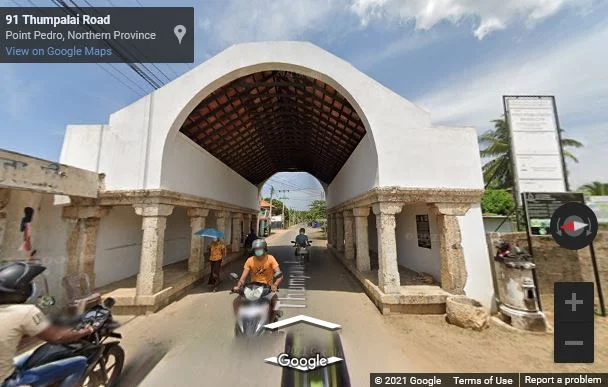
Theru Moodi Madam (Photo credit: Google Street View)
The Theru Moodi Madam (Tamil: தெருமூடி மடம்; Sinhala: තෙරුමූඩි අම්බලම) is an Ambalama (an old wayside rest) situated in Point Pedro in Jaffna District, Sri Lanka.
History
Ambalamas are traditional resting places built by locals to accommodate
wayfarers who were travelling to distant places. They were also used as a
place for people to gather, hold meetings and serve as a public place
in society. During the 16th, 17th and 18th centuries, Ambalamas were
spread all over the country. The inscriptions inscribed on the pillars of Theru Moddi Madam reveal that it was constructed in the 18-19 centuries by private individuals (Pushparatnam, 2014).
The structure
The architecture of Theru Moodi Madam is unique compared to other Ambalamas in Sri Lanka. Constructed on either side of the main road, this structure is 35 ft. in length and 34 ft. in width and consists of 16 limestone pillars decorated with carvings. In each of these pillars, the names of the donors who contributed to building this structure have been inscribed. The structure is covered by an arch-shaped roof.
In 2018, the roof and the wall of the Ambalama were damaged by an accident but reconstructed again in 2019 by the Department of Archaeology with the assistance of the City of Point Pedro Development Association.
Ambalamas in Jaffna have unique features.
Ambalama
in the Jaffna Peninsula is called Madam and it is generally different from similar structures
in other parts of the country. It consists of five components given below (Ragupathy, 1987);
1) Madam: the Ambalama itself
2) Sumaithangi: a stone platform used to keep the goods carried on the head, shoulder or waist of the traveller. Traditionally, the stone is said to be erected as a symbol of prayer, vowing for the soul of a mother who dies pregnant to rest in peace.
3) Aavuranchikkal: a stone erected for the cattle to relieve themselves from an itch called Thinavu by rubbing against the stone. It was constructed by means of a single stone with a height of 3 or 4 feet.
4) Keni: a big well meant for the cattle to quench their thirst.
5) Kinaru: a well, constructed to quench the thirst of both people and cattle.
Read the article: Aavuranchikkal and Sumaithangi in Jaffna Peninsula
A protected monument
The Therimudi doss house near the Pasupadeeshwara Temple on No. J/401 of the Point Pedro Grama Niladhari Division in the Point Pedro Divisional Secretary’s Division is an archaeological protected monument, declared by a government gazette notification published on 30 December 2011.
References
1) Pushparatnam, P., 2014. Tourism and monuments of archaeological heritage in Northern Sri Lanka. Author Publication. ISBN: 978-955-0811-08-3. pp.79-80.
2) Ragupathy, P. 1987. Early settlements in Jaffna, An archaeological
survey. Published by Mrs. Thilimalar Ragupathy. Madras. p.156.
3) The Gazette of the Democratic Socialist Republic of Sri Lanka. No: 1739. 30 December 2011. p.1090.
Location Map
This page was last updated on 30 April 2023

